I decided this year to experiment with making yogurt and soft cheeses aboard Legacy. In this post, I’ll talk about my initial experiments with yogurt. I decided that I wanted to make yogurt in as streamlined a manner as possible, with a minimum of specialized equipment.
Here is my yogurt making equipment: the black cylinder is an insulated lunch kit that I bought at Wal-Mart in Mazatlan for about US$8.00. It came with three small plastic containers inside for lunch items. I opted to use those containers elsewhere, because this one-liter clear plastic container fit perfectly inside. I bought two of the one-liter containers at Santa Fe Market at Marina Mazatlan for about US$1.25 each. That way I have one for my current batch, and one to be making a new batch. I also have a tiny plastic container that I use to hold a couple of tablespoons of yogurt as starter for my next batch. The only “specialized” equipment is a thermometer. We use a very good Thermopen, which is endlessly useful aboard, but any digital thermometer or dairy thermometer will work as long as the temperature range goes low enough.
I decided to use powdered milk to make yogurt because it stores easily. The favorite of most cruisers is Nestle Nido, which is a powdered whole milk. In order to streamline the process, I mix the milk directly in the saucepan I will use to heat it. Add 900 ml of water to a medium saucepan, then add the desired amount of milk powder. The Nido can calls for 13 tablespoons (about 130 grams) of powder to make a liter of milk. I like to add an extra 4 tablespoons to further thicken the yogurt. For me, it’s easier to just weigh out the powder, so I use about 150 grams. (An inexpensive digital scale that weighs in both pounds and kilograms is another useful item aboard.)
Mix the powdered milk, and then gently heat to a temperature of about 180 degrees. Check the temperature frequently as it will change rapidly! Once it reaches that temperature, remove from the heat and let the temperature drop to 116 degrees. Stir in your starter, using an up and down motion. I used prepared yogurt starter from Ricki the Cheese Queen for my first batch, then keep a small amount of yogurt from each batch as a starter for the next one. After a few batches, the yogurt will get thinner and I use a new packet of starter. You can also use a tablespoon of commercial yogurt as a starter. Make sure to buy a yogurt that lists “live culture of l. bulgaricus and s. thermophilus” among the ingredients.
Now the hard part is done. Pour the milk mixture into your container. Set it in your thermos, or use some other method to keep it warm, such as swaddling it in towels and putting it in the warmest part of the boat. Leave it undisturbed for at least 6 hours or up to 12 hours. The longer you leave it, the tarter and thicker the yogurt will be. After you refrigerate the yogurt, it will continue to thicken some.
Note: it is also possible to make yogurt with soy milk. Heat the milk to 110 degrees and add the starter. Cover and keep warm until it reaches the desired thickness.
We enjoy yogurt for breakfast or lunch with a variety of stir-ins: jam, honey, fruit (fresh, frozen, dried, or canned), shredded coconut, nuts, Grape-Nuts, or granola. It’s also delicious in a variety of savory applications including sauces, soups, and salads. Give it a try and have fun!
Heather, The Cruising Cook
| Illustrated Yogurt Making | |||

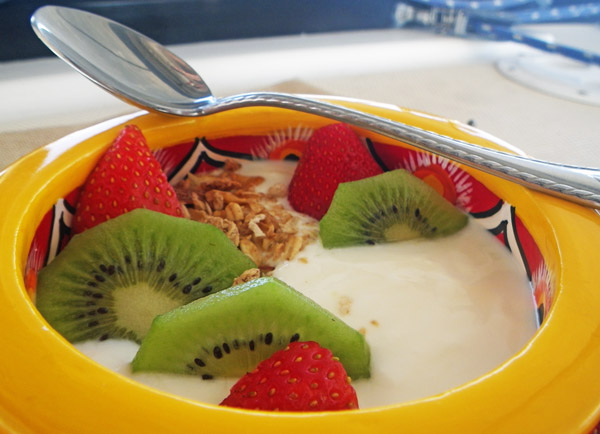
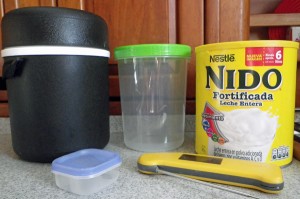
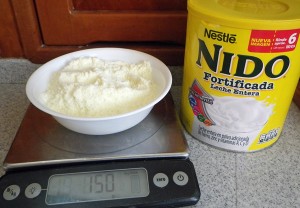
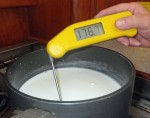
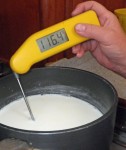
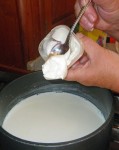
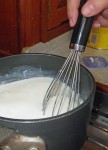

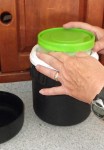
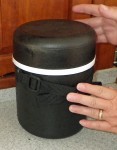
I’ve made yogurt aboard ever since my friend in Columbia showed me how. I have a different technique than you — more low tech. She told me the key was to keeping the mix away from metal — so I bought a new “teflon” lined saucepan. I heat the milk (I use a UHT liter), adding about a cup of powdered milk. I stir it with a wooden spoon, testing it to about 104 degrees (I use my wrist just like checking a baby’s bottle). While the milk is heating, I boil a pot of water. When the milk feels right, I slowly add my active yogurt and then pour it into a plastic container with a lid. Then I pour boiling water into two nalgene bottles, and put all three containers into an insulated six-pack holder. Then I wait 12 or so hours and enjoy! The key for boating is to be flexible and to be able to use what you can get your hands on in whatever port you happen to be! Enjoy that yogurt!
Thanks, Louise! Your technique sounds like a good one as well. Glad to know that the UHT milk works for you. It’s probably because it’s ultra-pasteurized that you don’t have to do the initial 180 degree heating. I like your method of keeping the yogurt warm. Like you said, it’s important to be flexible and make use of what you have!